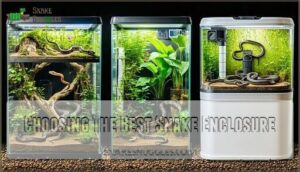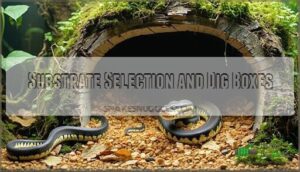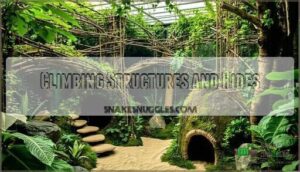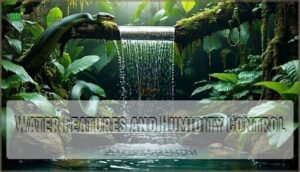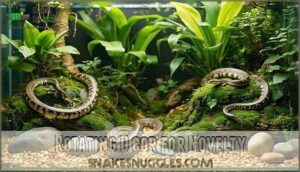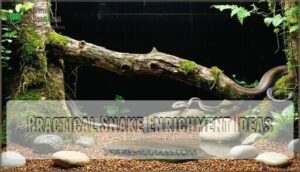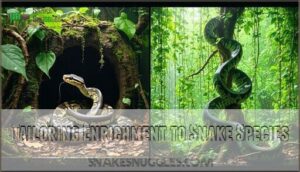This site is supported by our readers. We may earn a commission, at no cost to you, if you purchase through links.
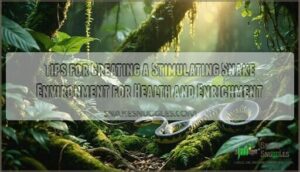
Your captive snake retains these same drives, but without opportunities to express them, stress hormones accumulate and natural behaviors atrophy.
Creating a stimulating snake environment transforms basic survival housing into an active space that bolsters both physical health and psychological well-being. The difference shows up in shedding quality, feeding response, and overall vitality.
Table Of Contents
Key Takeaways
- Enrichment isn’t cosmetic—it directly improves immune function, feeding response, and shedding quality by reducing stress hormones and encouraging natural behaviors like foraging, climbing, and exploring.
- Your snake’s enclosure should include thermal gradients, multiple hides, climbing structures or dig boxes (depending on species), rotating décor every one to two weeks, and puzzle feeders to prevent sensory deprivation.
- Arboreal snakes need vertical space with branches and elevated hides, while terrestrial species thrive with ground-level enrichment and burrowing opportunities—research your snake’s natural habitat to match its specific needs.
- Watch for stress signals like defensive posturing, refusal to eat, or frantic pacing after adding new items, and remove anything that triggers these responses to keep enrichment safe and beneficial.
Why Snake Enrichment Matters
Giving your snake the right kind of enrichment can make a real difference in its well-being. A stimulating environment encourages healthy behaviors and reduces stress.
Here are the main benefits and some things to consider when setting up your snake’s habitat.
Benefits of Environmental Enrichment
A stimulating reptile environment does more than just look good—it encourages natural behaviors like foraging and climbing, which keeps your snake alert and active.
This kind of enrichment cuts down on stress and boredom, helping your snake stay sharp while keeping them physically healthy.
With reptile behavioral enrichment, you promote exploration and choice, directly improving your snake’s mental and physical wellbeing every day.
Impact on Snake Health and Behavior
You’ll notice real changes in your snake’s health and behavior as you enrich their environment. For example:
- Brain volume increases, supporting sharper sensory processing.
- Activity diversity flourishes—climbing, exploring, and foraging become daily routines.
- Cognitive performance improves, with snakes solving puzzles and adapting quickly.
These benefits depend on species responses, so tailor enrichment to your snake’s natural habits. Providing varied substrates encourages exploration.
Preventing Stress and Boredom
A varied environment doesn’t just keep your snake active—it actively pushes back against stress and boredom.
Things like puzzle feeders and rotating décor give snakes real cognitive challenges, which strengthens mental stimulation and cuts down on repetitive behaviors.
Regular behavioral monitoring lets you spot stress early, while novelty and physical exercise promote better animal welfare and stress reduction through thoughtful environmental enrichment.
Choosing The Best Snake Enclosure
Your snake’s enclosure choice directly impacts how well it thrives—both physically and behaviorally. Before committing to a setup, there are a handful of essentials worth considering.
Here’s what you should focus on when picking the right setup.
Enclosure Size and Security
Think of your snake’s enclosure as its whole world—getting the size and security right is the first step to keeping your pet safe, active, and comfortable.
Make sure you:
- Meet the species’ space requirements and proper enclosure dimensions.
- Use an escapeproof enclosure with secure locking.
- Choose adequate glass thickness for strength.
- Regularly inspect for any potential escape points.
Materials and Ventilation
Whether you’re setting up a brand-new habitat or upgrading an old one, picking the right materials and making sure your snake gets enough fresh air both play a huge role in keeping your pet healthy. Safe materials keep toxins out; airflow design controls humidity impact. Here’s a quick look:
| Ventilation Types | DIY Options |
|---|---|
| Screen lids | Drilled vents |
| Side slats | Mesh panels |
| Top grills | Removable lids |
Heating, Lighting, and Humidity Needs
When setting up your snake’s enclosure, focus on creating thermal gradients with a reliable heat source and a defined basking spot. UVB lighting promotes health for some species. Regular temperature monitoring helps maintain safe ranges.
Consistent humidity levels are key—use water features or misting for humidity and always adjust based on your snake’s specific heating and lighting requirements.
Essential Elements of a Stimulating Habitat
A well-designed habitat gives your snake room to explore, exercise, and feel secure. The right features make daily life more interesting and support natural behaviors.
Here’s how to build an enclosure that really works.
Substrate Selection and Dig Boxes
Choosing the right substrate is like laying the foundation for your snake’s daily adventures, giving them a safe place to dig, explore, and express natural behaviors. Consider these essentials:
- Match Dig Box Size to your snake.
- Prioritize Substrate Safety.
- Encourage burrowing behavior.
- Monitor Cleaning Frequency.
- Use Enrichment Rotation to keep substrate fresh and engaging.
Climbing Structures and Hides
Imagine your snake weaving through sturdy branches or curling up in a cozy hide—these simple features turn an ordinary tank into a playground full of discovery. Secure climbing structures made from natural materials support arboreal considerations, while hide variety gives your reptile enclosure depth. Always match size appropriateness to your snake’s needs.
| Climbing Structures | Hides and Caves |
|---|---|
| Secure Climbing | Hide Variety |
| Natural Materials | Size Appropriateness |
| Arboreal Considerations | Snake Habitat |
| Enclosure Integration | Reptile Enclosure |
| Easy Cleaning | Privacy Options |
Water Features and Humidity Control
Did you know that keeping the right humidity and adding water features can turn your snake’s enclosure into a mini rainforest, helping your pet stay healthy and active? Humidity gradients, misting systems, and a clean water dish support hydration methods and shedding aid.
Good water quality and humidity and water management also offer sensory enrichment, improving your reptile habitat.
Rotating Décor for Novelty
Adding new décor, like fresh hides or climbing branches, keeps your snake’s world interesting and prevents behavioral habituation. Rotating items every week or two encourages exploratory responses and delivers cognitive benefits. You’ll see more natural behaviors and less stress. Creating a comfortable habitat with functional decor items can greatly reduce stress. Match changes to your snake’s species preferences for best results.
- Weekly décor rotation
- New climbing structures
- Varied hides
- Textured surfaces
- Safe enrichment objects
Practical Snake Enrichment Ideas
If you’re looking to make your snake’s habitat more engaging, there are plenty of simple ways to get started. Each idea offers a chance to boost your pet’s health and curiosity.
You can experiment with several practical setups right in your own enclosure.
Puzzle Feeders and Foraging Activities
When you offer puzzle feeders and foraging activities, your snake gets the chance to work for its food just like it would in the wild. Adjust puzzle complexity and prey size to match your snake’s abilities.
Use safe materials to create food enrichment, lay scent trails, and vary foraging frequency. These foraging opportunities promote natural snake behaviors and healthy foraging behavior.
Introducing Safe Scents and Textures
Puzzle feeders get your snake moving and hunting for meals. Similarly, adding new scents and textures opens up fresh ways for them to explore their world.
For sensory enrichment, try these five ideas:
- Scent introduction with herbs or safe leaves
- Texture variety using different substrates
- Rotating décor for novelty
- Olfactory stimulation with scent trails
- Monitor behavioral responses to avoid sensory overload.
DIY Enrichment Using Household Items
You don’t need fancy equipment to keep your snake curious—simple household items can become creative enrichment tools right alongside new scents and textures. Try cardboard boxes as creative hides, PVC pipes for tunnels, or fabric textures like fleece for environmental enrichment.
Safe plants and varied structures encourage natural behaviors, providing mental stimulation and habitat enrichment without breaking the bank.
Monitoring for Stress and Safety
Even the best enrichment setup can backfire if your snake shows signs of stress. Watch for defensive posturing, refusal to eat, or frantic pacing after introducing new items. Remove anything causing behavioral changes immediately.
Check for injury prevention gaps and escape risks in your escape-proof enclosure, and maintain hygiene practices. Prioritizing stress reduction and animal welfare protects snake health and wellbeing while keeping enrichment safe.
Tailoring Enrichment to Snake Species
Not all snakes live the same way in the wild, so their enrichment needs aren’t one-size-fits-all. A ball python’s ideal setup looks very different from what an arboreal species needs.
Here’s how to match enrichment to your snake’s natural behavior.
Ball Python-Specific Enrichment Tips
Ball pythons might’ve a reputation for being laid-back, but even these calm snakes thrive when their environment challenges their minds and bodies. Start by offering multiple hides—both warm and cool—to let your ball python choose where to settle. Provide adequate enclosure size for movement, and rotate décor like branches or cardboard tubes to spark curiosity.
Vary feeding habits with puzzle feeders or different prey placement to encourage natural hunting instincts. Despite their gentle temperament, ball pythons benefit from occasional supervised handling and exploration outside their enclosure.
Ball python enrichment keeps these beautiful snakes—regardless of morph variations—engaged and healthy.
Arboreal Vs. Terrestrial Species Needs
Different snake species don’t all live the same way in the wild, and their enclosures shouldn’t either. Arboreal species need vertical space with climbing branches and elevated hides, while terrestrial species thrive with ground-level enrichment and dig boxes.
Adjust enclosure height, humidity gradients, and basking differences accordingly. Species-specific enrichment strategies—custom habitat enrichment for each type—deliver the environmental enrichment your snake actually needs.
Researching Natural Behaviors for Success
Your snake’s natural habitat and behaviors should guide everything you do with enrichment.
Look into how they hunt, where they hide, and how they move in the wild—then mirror those activity patterns and behaviors in their enclosure.
- Study habitat complexity in their native range to replicate vertical or horizontal structures
- Examine sensory ecology to provide appropriate visual, tactile, and chemical stimuli
- Observe species-appropriate behaviors like burrowing depth or climbing height preferences
- Document reptile behavior patterns to adjust enrichment timing and intensity
Promoting natural snake behaviors through species-specific enrichment strategies transforms generic care into truly responsive husbandry.
Frequently Asked Questions (FAQs)
How often should enrichment items be changed?
Enrichment activities should be rotated every one to two weeks to maintain novelty and mental stimulation.
Species-specific enrichment strategies may require different cleaning frequency based on item degradation and behavioral changes observed in your snake.
Can multiple snakes share the same enclosure?
Most snake species shouldn’t share an enclosure due to cohabitation risks like aggression, stress, and disease transmission.
Species compatibility varies, but even compatible snakes need adequate space requirements, strict quarantine protocols, and careful monitoring for aggression signs in any habitat design.
What temperatures are safe for snake habitats?
Safe temperatures vary by species, but most snakes need a basking spot between 85–95°F and a cooler side around 75–80°F. Nighttime temperature drops to 70–75°F are natural.
Use thermostats to calibrate heat sources and maintain proper temperature control.
How do you introduce a new snake?
Improper introductions cause nearly 70% of reptile health problems—making quarantine essential.
Set up a separate enclosure for your new snake and keep it isolated for at least 30 days. Between handling sessions, wash your hands thoroughly to prevent cross-contamination.
Use scent swapping through substrate exchange to familiarize your established snake with introducing various smells.
Monitor behavior closely during gradual introduction, adjusting your feeding schedule as needed for stress reduction.
Are live plants safe for snake enclosures?
Yes, live plants can thrive in snake enclosures if you choose non-toxic species and use organic soil without fertilizers. Plant hardiness matters—select foliage that tolerates enclosure humidity and occasional crushing.
Live plants improve environmental enrichment, creating natural habitat complexity that benefits reptiles while improving air quality and visual appeal.
Conclusion
A barren tank versus a thoughtfully layered habitat—the contrast speaks volumes. When you invest time in creating a stimulating snake environment, you’re not decorating; you’re restoring instincts that captivity quietly strips away.
Each branch, texture, and scent opportunity becomes a thread that connects your snake to its ancestral blueprint. The payoff isn’t just behavioral—it’s physiological. A snake that explores, investigates, and engages doesn’t just look healthier; it is healthier, with sharper immune responses and steadier appetite cycles that make every shed count.
- https://www.aza.org/behavior-scientific-advisory-group?locale=en
- https://youtube.com/shorts/2nO8ULsQQEU
- https://www.youtube.com/playlist?list=PLNbZzsRecQ2ac3qvbWHmR2jxsl0B0jUtx
- https://pubmed.ncbi.nlm.nih.gov/40116129/
- https://www.ottoenvironmental.com/enhancing-snake-welfare-through-environmental-enrichment/

